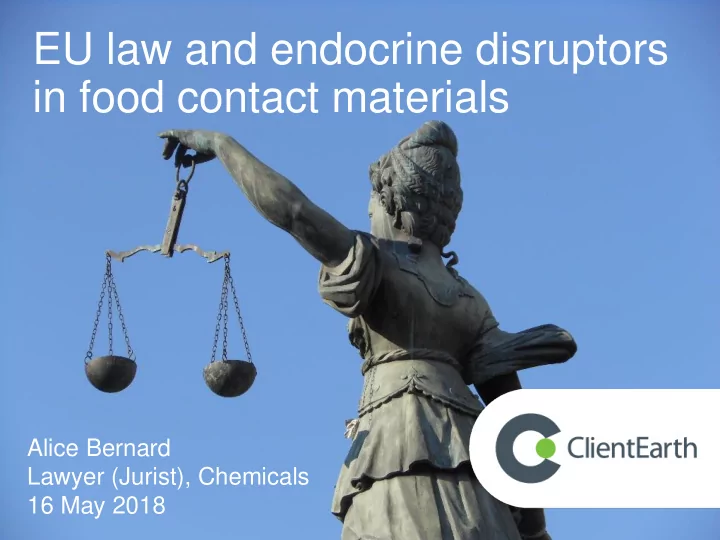

EU law and endocrine disruptors in food contact materials Alice Bernard Lawyer (Jurist), Chemicals 16 May 2018
Introduction to ClientEarth • ClientEarth is a non-profit environmental law organisation • We use law, science and policy to tackle key environmental challenges • We work on the challenges raised by endocrine disruptors, pesticides, plastics, nanomaterials, circular economy, REACH
Contents 1.Endocrine disruptors in food contact materials today: “safe level” approach 2.Attitude to risk: a societal choice
1. Endocrine disruptors in food contact materials today: “safe level” approach
Endocrine disruptors (EDCs) A chemical that can mimic, interfere, or block our hormones, and disturb as a result the normal development and functioning of our bodies EDCs have been associated with many health issues as serious as cancer, infertility, learning disabilities, diabetes and others More information on endocrine disruption from the Endocrine Society: see video
Pesticides Food Contact Material (plastic) EU law Regulation 1107/2009 Regulation 1935/2004 Regulation 396/2005 Regulation 10/2011 Origin of the risk Consumer exposed to chemicals - Consumer exposed to chemicals – residues - in food migrated - in food Solution EU approval system EU approval system Positive list of authorised substances Acceptance of Principle: NO YES - “Safe level” on case by case presence of endocrine (derogations) Specific Migration Limit set per disruptor in food ? chemical If proper implementation: no EDCs Result Authorised with “safe levels”: 5 official EDC (ECHA) + 13 EDC ( SINlist) + many other unidentified?
2. Attitude to risk: a societal choice
PROS No Approval “Safe” Level Benefit Benefit public interest businesses
CONS No Approval “Safe” Level
False alarms v. failures to prevent harm Scarce examples of true “ false alarms” in the field of health and environment European Environment Agency study “Late lessons from Early Warnings” Volume II ( Chapter 2) Many examples of failure to prevent harm based on mistaken scientific estimations: BPA: the more time passes, the more knowledge (studies), the lower the “safe level” Attitude towards risk: a societal choice
“Safe level” – disputed for EDCs • The most recent review of scientific evidence by EU agency (ECHA, 2017) questions the possibility to set a “safe level” for endocrine disruptors • Hormones play their messenger role in our bodies at low doses: timing of exposure may matter more than the dose For more information: https://www.endocrine.org/topics/edc/what-edcs-are/faq
Useful resources EDCfree statement 2018 calling for an EU EDC strategy Green Science Policy Institute: video on Bisphenols and Phthalates Little things matter: video “Cause or Cure? Is the Relentless Pursuit of a Cure Hazardous to our Health ?” ChemTrust report: From BPA to BPZ: a toxic soup? ChemTrust Presentation May 2018: EU regulation of chemicals in Food Contact Materials: Outdated, ineffective and full of holes
Alice Bernard Lawyer (jurist), Chemicals abernard@clientearth.org www.clientearth.org @ClientEarth @ChemicalsCE
Recommend
More recommend